The 2023/24 Premier League title race is an absolutely thrilling one, with Liverpool, Arsenal, and Manchester City all battling it out with 13 games remaining (14 for City). Over the weekend, Liverpool kicked things off with an emphatic 4-1 win at Brentford in their early Saturday fixture, while Arsenal blew Burnley away with a 5-0 thrashing later that day. These results acted as a message to Manchester City, who played their fixture on the Sunday – a 1-1 draw at home to Chelsea.
This tactical analysis will provide some insight into the key tactics deployed by Mauricio Pochettino as his side looked to disturb City’s afternoon, with the analysis also looking at how Pep Guardiola responded in this riveting tactical battle.
Lineups
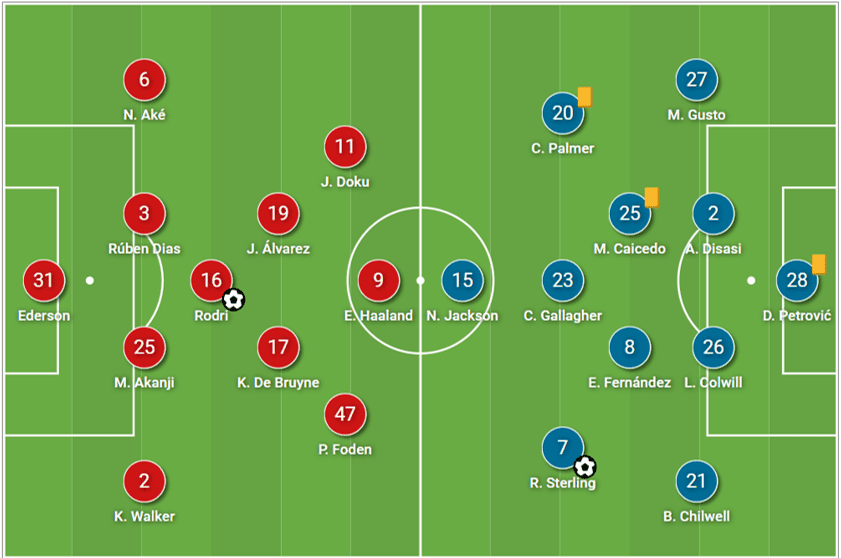
City lined up in a 4-3-3 that went through several tweaks throughout the match, dependent on Chelsea’s approach or City’s attacking intent. For example, there were moments where they adopted a 3-2-5 formation in attack, but in other times went into a 4-2-3-1 shape that saw Julián Álvarez drop deeper and play a double pivot role alongside Rodri. Jérémy Doku occupied the right flank while Phil Foden started on the right flank, with midfield maestro Kevin De Bruyne operating in multiple midfield roles throughout the match to combat Chelsea’s tactics. Manuel Akanji would be seen to push into midfield on some occasions, turning City’s backline into a back three – this also allowed Álvarez to relax on his defensive duty slightly.
Chelsea started with a 4-2-3-1 formation that also experienced some fluidity during the 90 minutes. Cole Palmer had to work closely in a defensive capacity with Malo Gusto on the right flank, while Conor Gallagher also had an important defensive role, which we will discuss in more detail later in the analysis. Chelsea’s high-intensity pressing approach gave them opportunities to attack on the break, which is where the likes of Raheem Sterling and Cole Palmer proved to be important.
Chelsea’s Press
From minute one, Chelsea were intent on disrupting Manchester City’s usual possession dominance. They aimed to do this with a high press which included man-to-man defensive responsibilities. City simply aren’t used to facing these tactics and, as we will see later in this analysis, Chelsea’s press forced Guardiola to make some tactical tweaks.
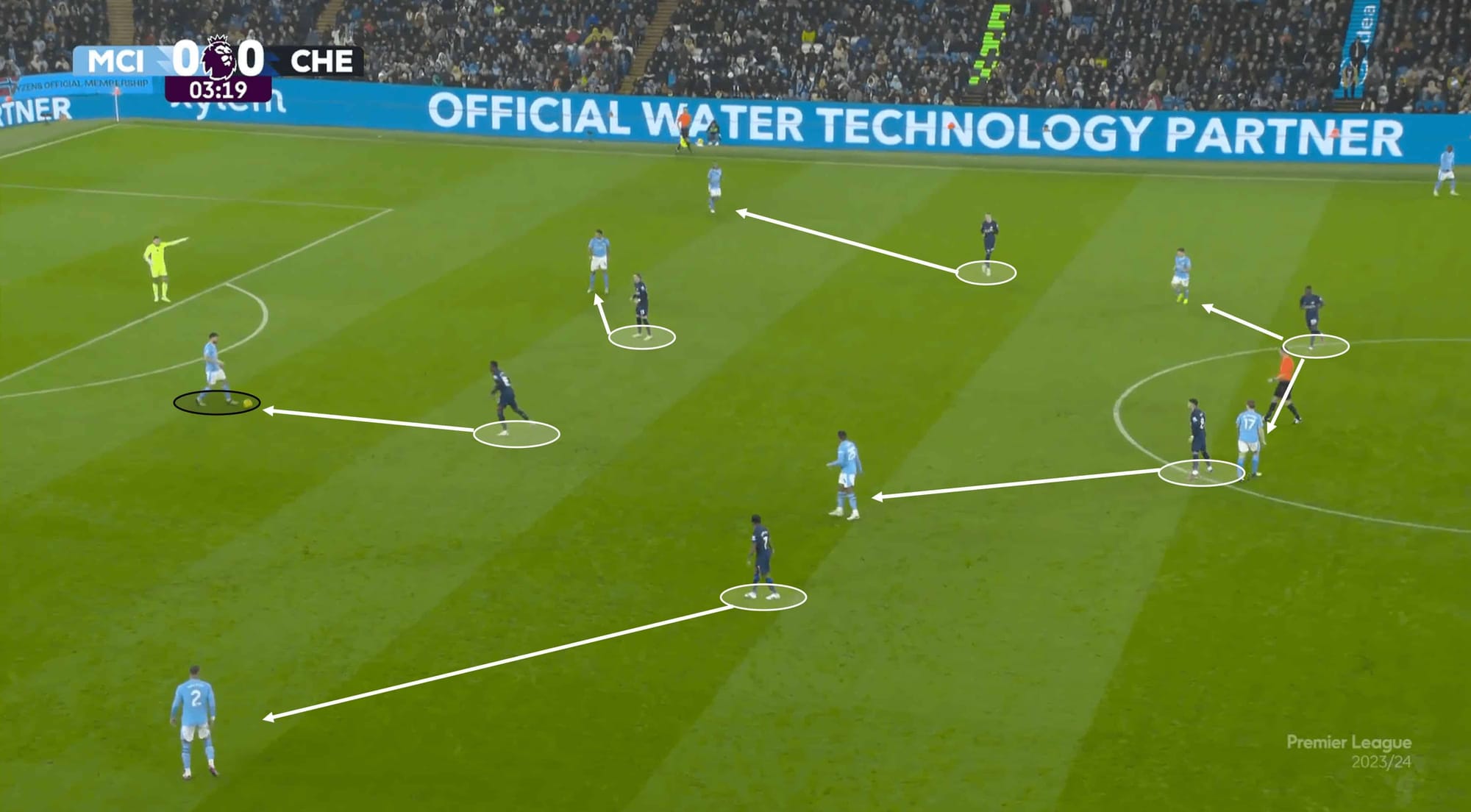
Blocking central areas was of high importance to Pochettino, which is why, even in this high press, the two wide players (Sterling and Palmer) are tucked inside, to suffocate that central space along with Moisés Caicedo and Enzo Fernández. The positioning of Sterling and Palmer was just balanced enough to allow them to press City in the full-back positions if required.
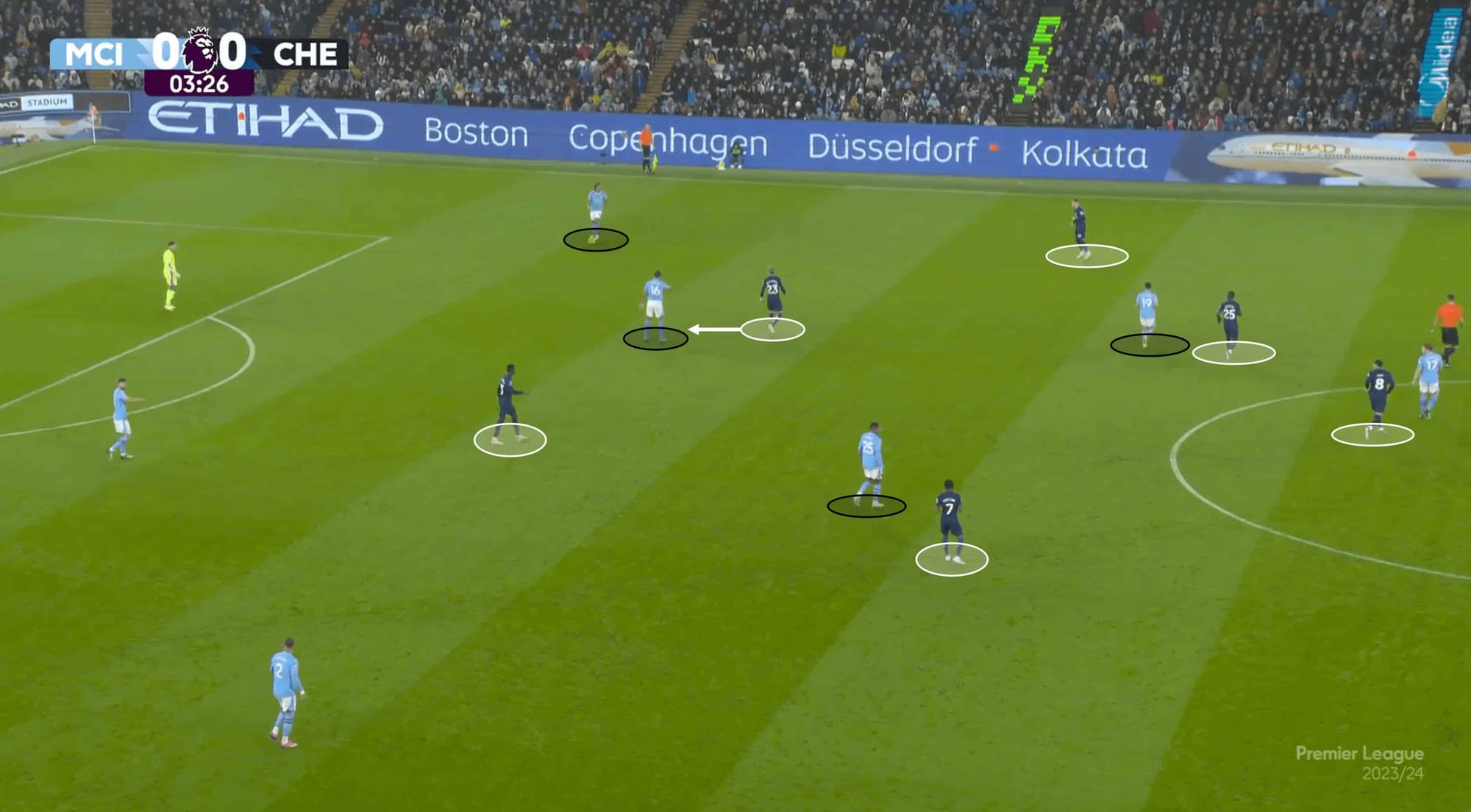
Chelsea’s press was well-structured and thought out by Pochettino and co., with the Blues showing a good understanding of when and where to inject some intensity into the pace. Another key element of their tactics was knowing which key City players to focus on and try to limit their influence on the ball.
In a typical Manchester City build-up phase, holding midfielder Rodri is highly active and important, often being the starting point for attacking moves, particularly when City have the ball inside their own half. Conor Gallagher was the man tasked with being a constant presence and nuisance to the Spaniard, with the Chelsea midfielder simply keeping near him to limit how much he received the ball and, more importantly, what he could do when he did receive the ball in these areas.
It was important for Gallagher not to go diving in or acting with an over-the-top intensity because City, via Rodri, would just play around him and break into midfield with ease. This, of course, brought about the need for man-to-man marking tactics.
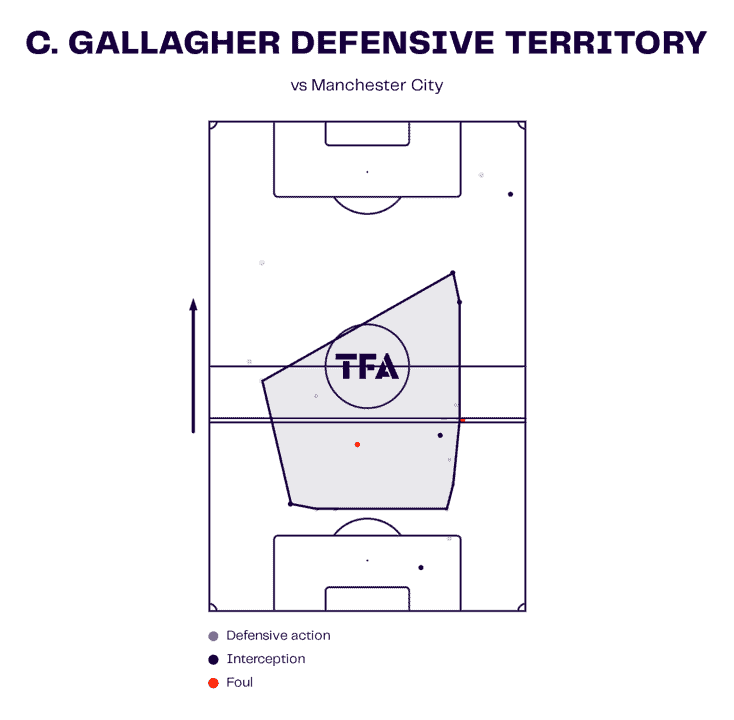
Taking a closer look at Gallagher’s defensive territory from this game, we get an insight not only into his positioning but also into where City often looked to play. That spike at the top of Gallagher’s defensive territory would be the area where Rodri would often locate himself, toward the left side of the pitch as City looked to target and overload the left flank. As you can see, Gallagher did not make many challenges high up the pitch, which relates to the point we made prior about his role of just limiting Rodri and forcing him to play backwards.

As we mentioned earlier, blocking central access was high on Chelsea’s list of priorities – players like De Bruyne can be influential from a range of positions but blocking that direct central link up from De Bruyne to Erling Haaland was important. Additionally, Chelsea’s compact midfield, positioned closely to the centre-backs, gave them enough of an overall defensive presence to allow the full-backs to push out wider to mark the wingers – as you see by Gusto’s marking of Doku on City’s right side.
Álvarez’s role in midfield
Julián Álvarez has played as a central midfielder for Guardiola’s side on a number of occasions this season, but this time he was given slightly more defensive responsibility, which came with pros and cons. He operated in a double pivot with Rodri in a bid to give City a better chance of playing out from the back following Gallagher’s man-marking – here’s what his role included on and off the ball, and why he became a target that Chelsea looked to exploit.
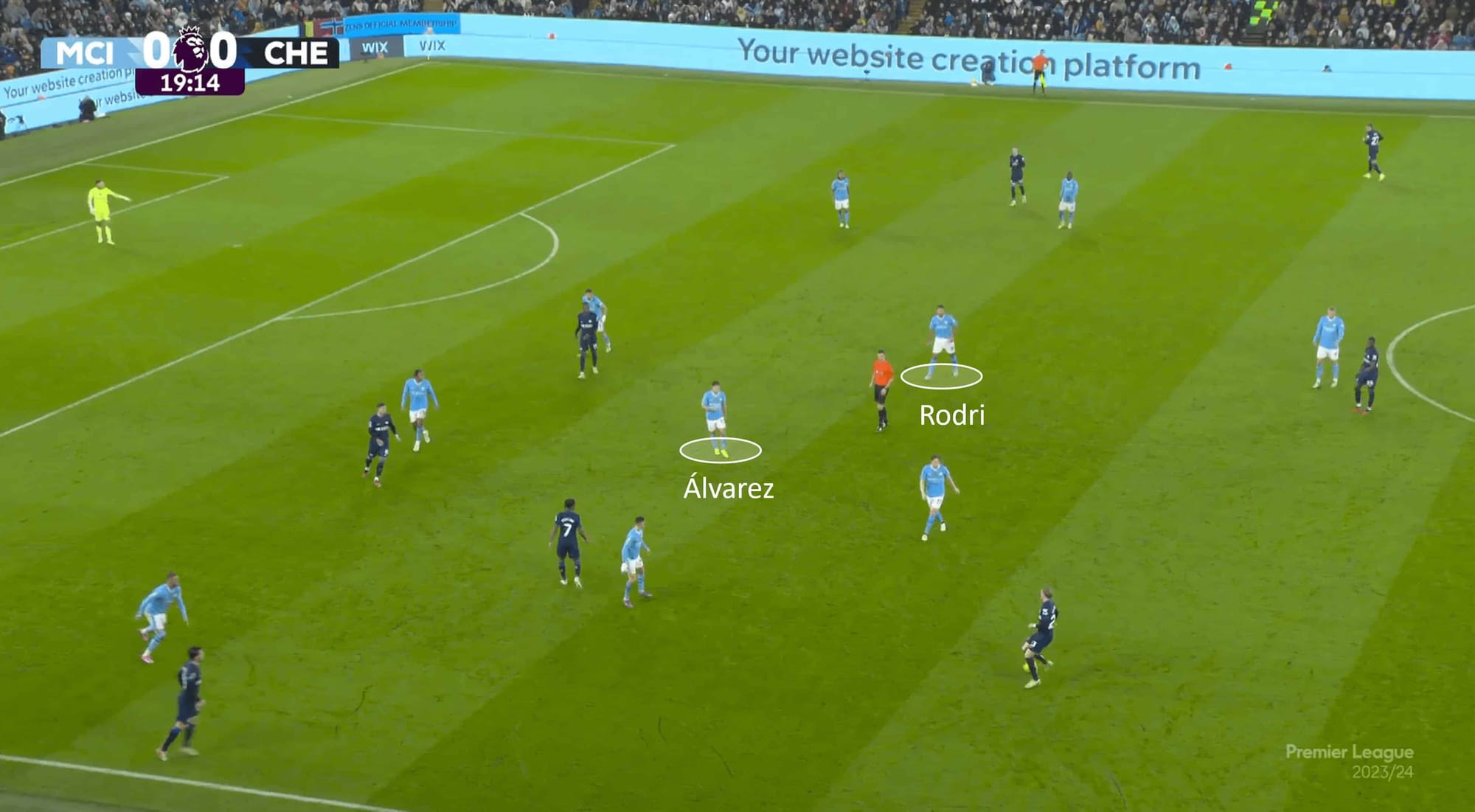
This image gives us an understanding of how Álvarez would be positioned in a defensive capacity alongside Rodri; he would often appear on the left instead of the right, however. As you can see, he isn’t marking anyone, nor is Rodri – this is because Chelsea often looked to focus their attacks down the flanks and had very little central attacking presence in midfield.
They would, of course, look to utilise central areas once they got into more dangerous areas to provide support to Jackson, which is where Álvarez’s added presence was of benefit. However, as you may imagine from a player who is naturally a centre forward, Álvarez’s defensive attribute set is lacking in some areas.
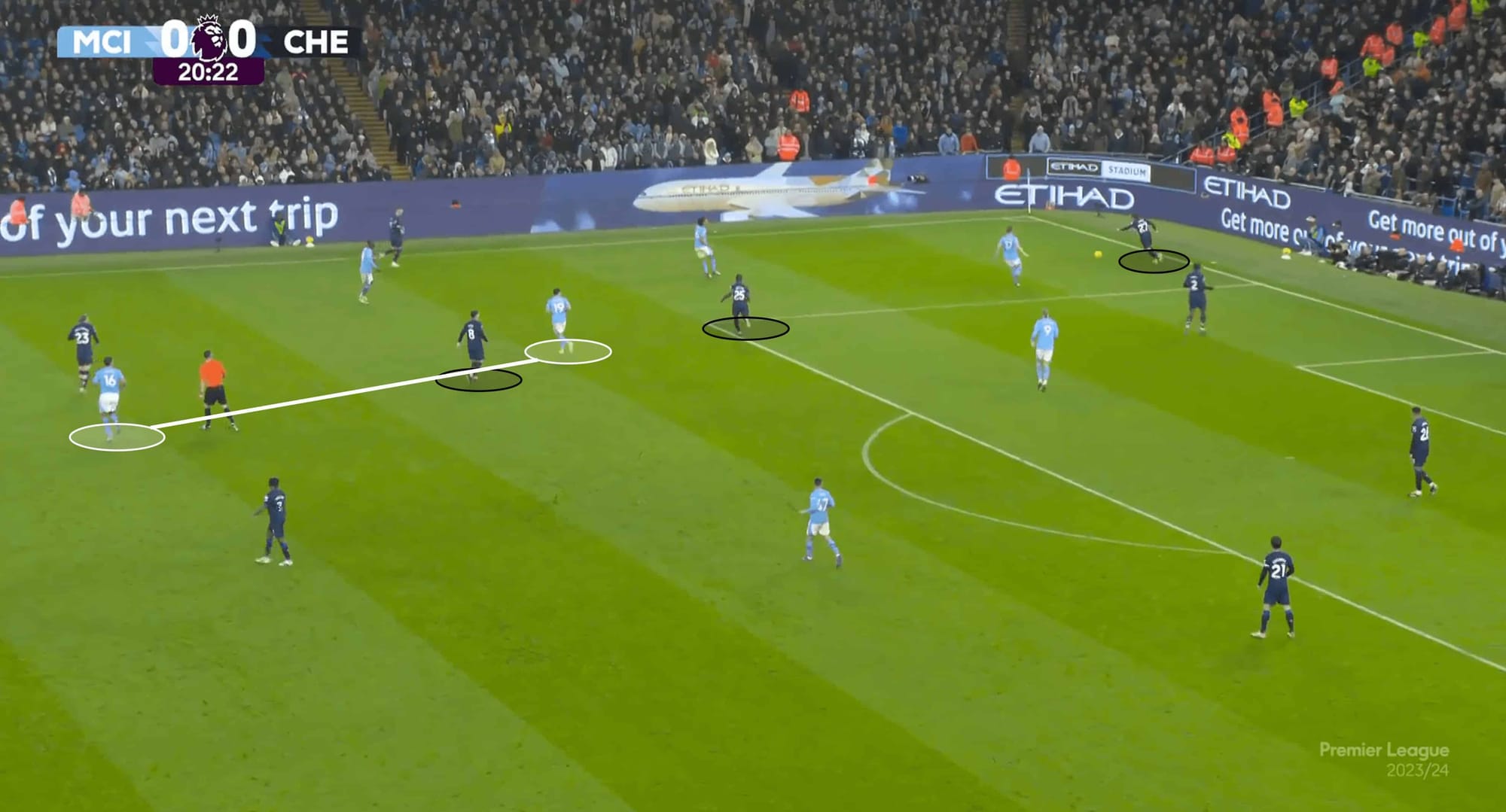
Chelsea weren’t the only ones using a high press in this fixture. City looked to force mistakes from the Blues in their own half, with pressing often coming from De Bruyne, Foden and/or Doku; Haaland would usually sit a little deeper if De Bruyne went in for the press. In terms of the two deeper midfielders, Rodri and Álvarez, the latter would be seen to push higher, ready to press a Chelsea shirt in those areas if needed. An additional benefit of this positioning was his ability in transitions if City were to win the ball in these dangerous locations.
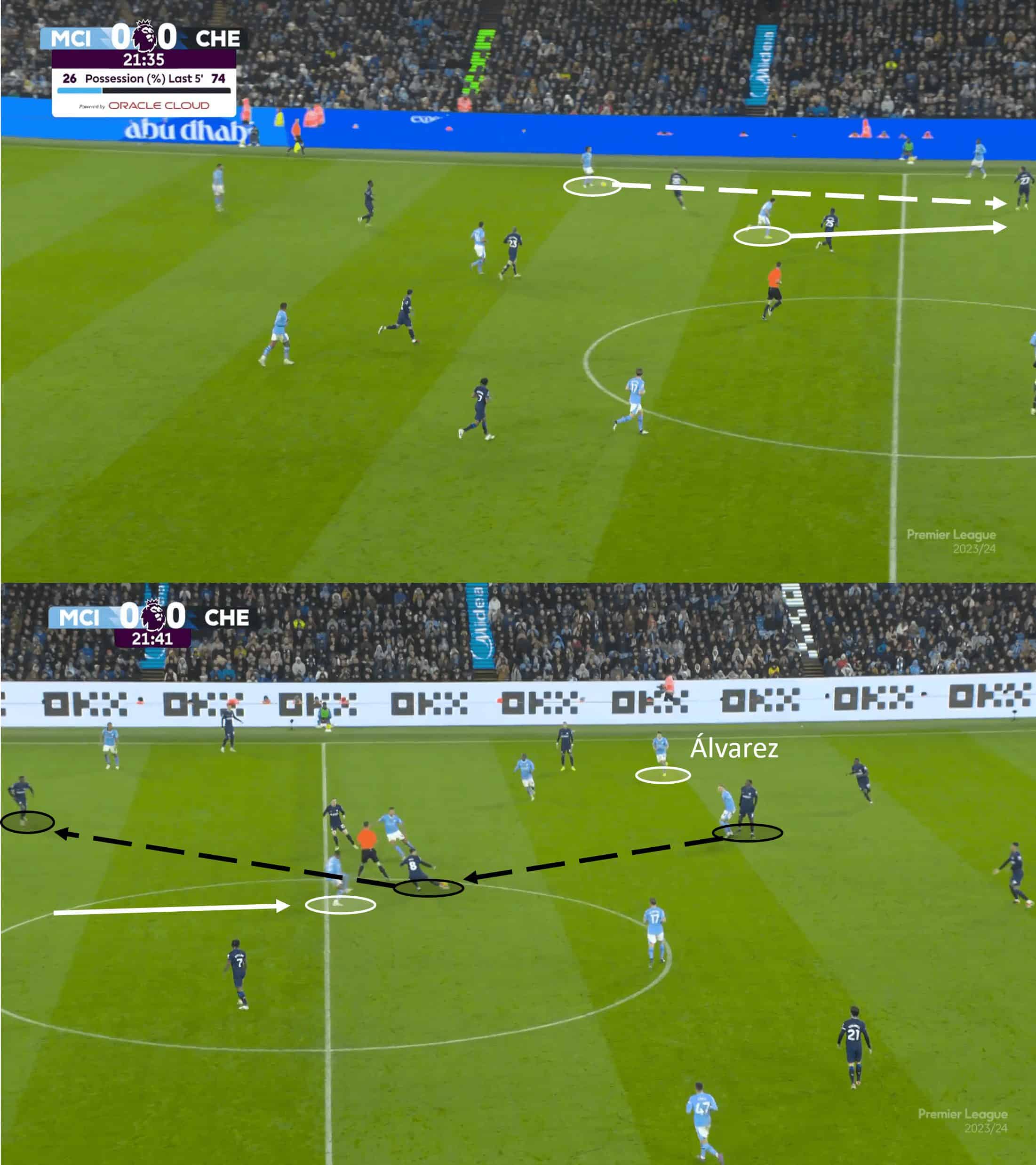
His role in possession was where we saw some issues arise. On more than one occasion, the Argentinian made a bursting run from deep midfield into a more attacking zone, which only left City’s central midfield area exposed in some scenarios, with players like De Bruyne, Foden, and Doku already playing an attacking role with a high presence – it effectively left Rodri alone and exposed, or it could have done if Akanji didn’t step into midfield to add some presence.
However, even with the added presence of the Swiss defender alongside Rodri, Chelsea were still able to play quickly enough to target the vulnerability and capitalise with an attempted counter-attack. As we saw, counter-attacks were a key attacking principle for Chelsea in this game, looking to break forward quickly in transitions as they aimed to catch City off-guard – which is where their goal came from.
City’s activity in wide areas
Even in a game that was an intriguing tactical battle where Chelsea did pose attacking threats, Guardiola’s side still amassed 67% possession and registered 31 shots – 3.53 xG. As we mentioned, City occasionally faced some issues in breaking various Chelsea units down but still posed a huge threat going forward, despite Chelsea’s impressive off-the-ball tactics. In possession, initially, City would look to stretch the pitch to combat Chelsea’s compact shape – this segment of analysis looks at why City had to make further tweaks to get Foden and Doku involved in the game more.
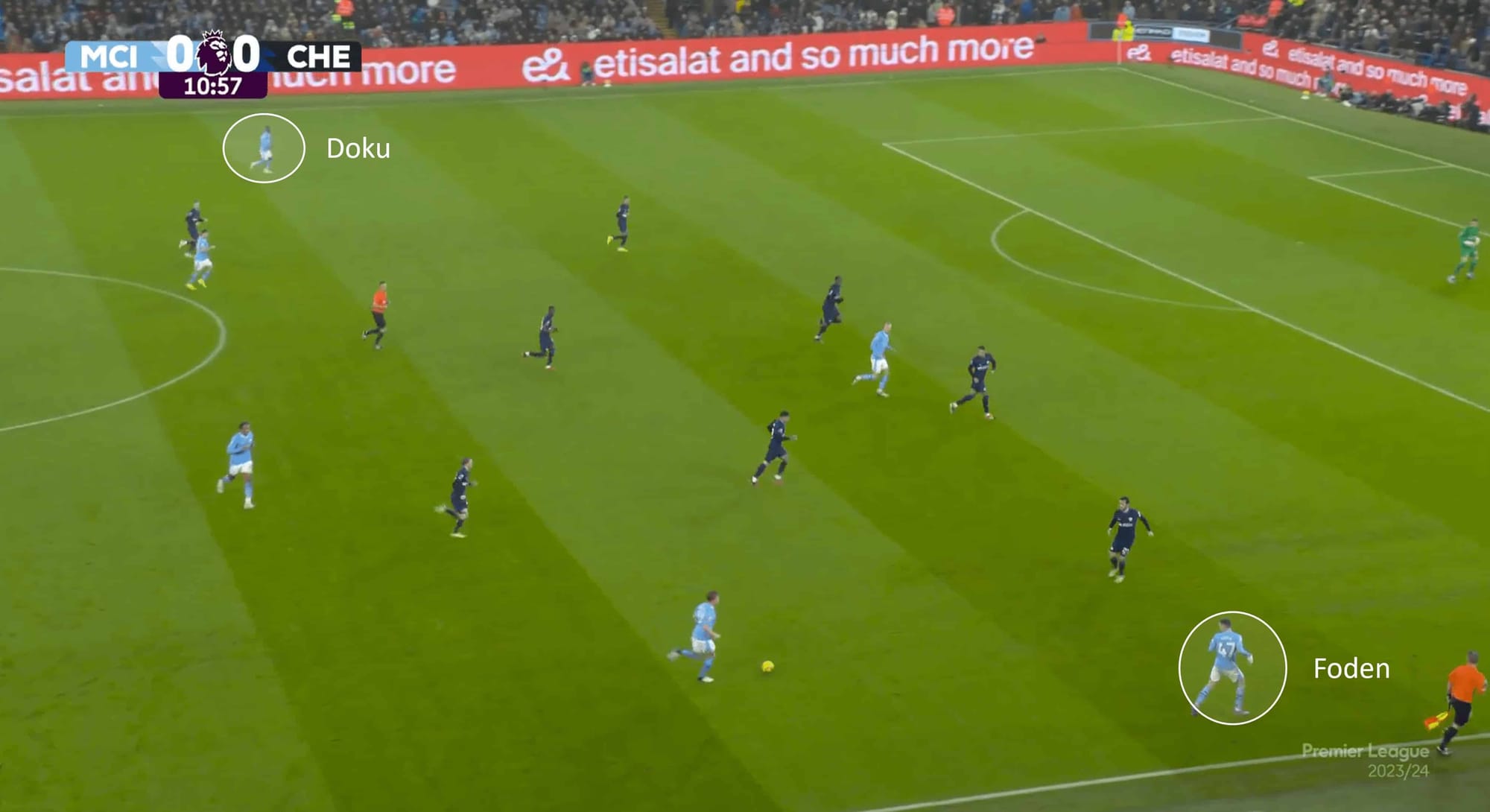
As discussed, Doku and Foden would both take up wide positions when City took the ball forward. While Doku had some success playing the wide attacking winger role, he did face the issue of being doubled up on by Chelsea’s defence. Meanwhile, Foden struggled to have a major impact when playing this wider role, so City made further tweaks to get him into central areas where he could be much more effective.
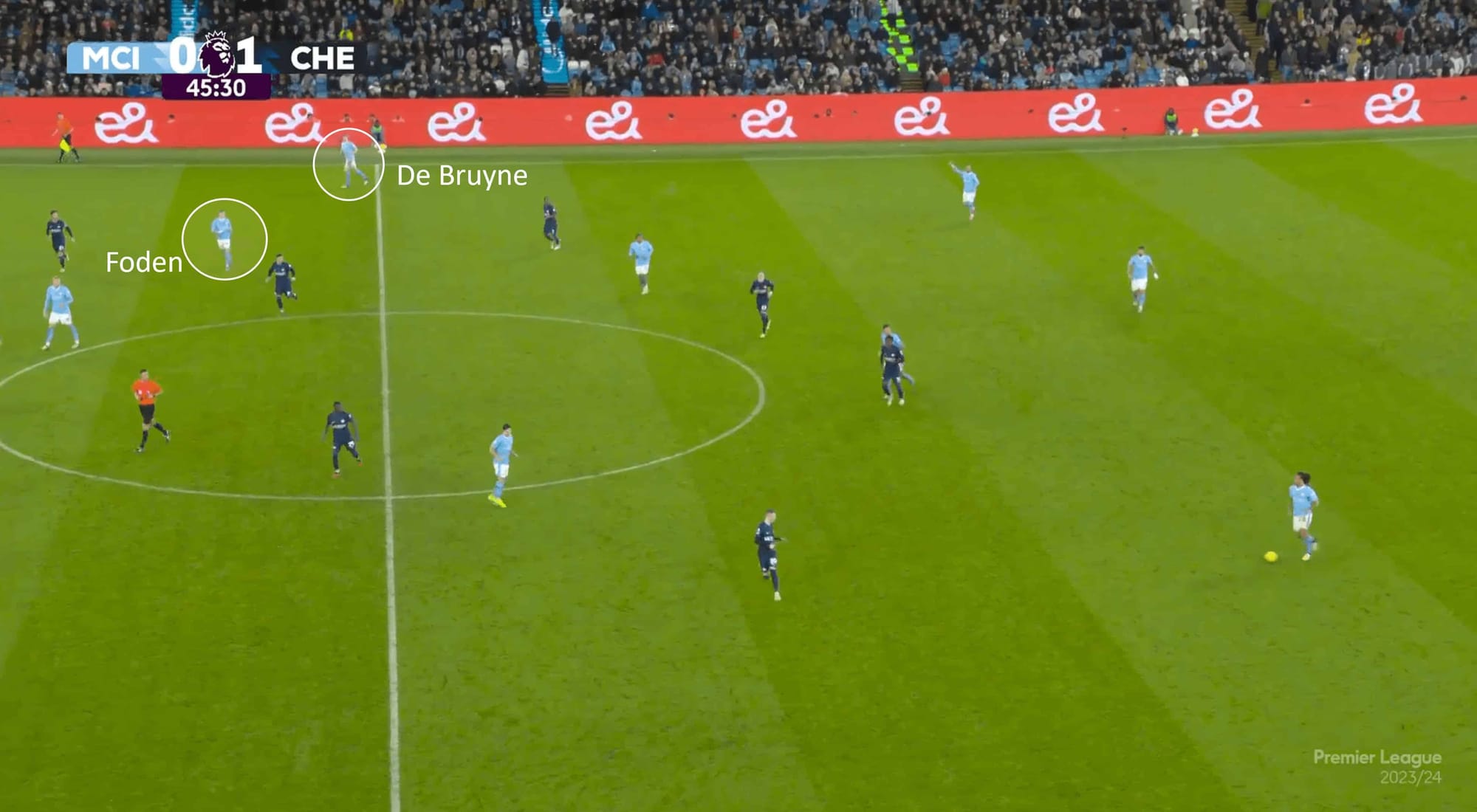
One of the solutions we saw being put in place was to utilise De Bruyne’s versatility as we saw him push into a right midfield position on some occasions, allowing Foden to drift inside and exploit pockets of space between Chelsea’s midfield and back four. De Bruyne is no stranger to adopting a variety of roles during one match, and while he doesn’t possess the traits of what would be considered a modern winger – rapid pace, 1v1 dribbling ability etc., when he does receive the ball in wide areas, he effectively becomes a wide playmaker, and a dangerous one at that.
Another solution City deployed to get Foden into central areas, when they had possession in Chelsea’s half, was to drop De Bruyne deeper, essentially playing an RCB position momentarily – Walker being at RB also provided width and overall presence which allowed Foden to attack centrally while De Bruyne’s playmaking ability could still be called upon from a deeper range.
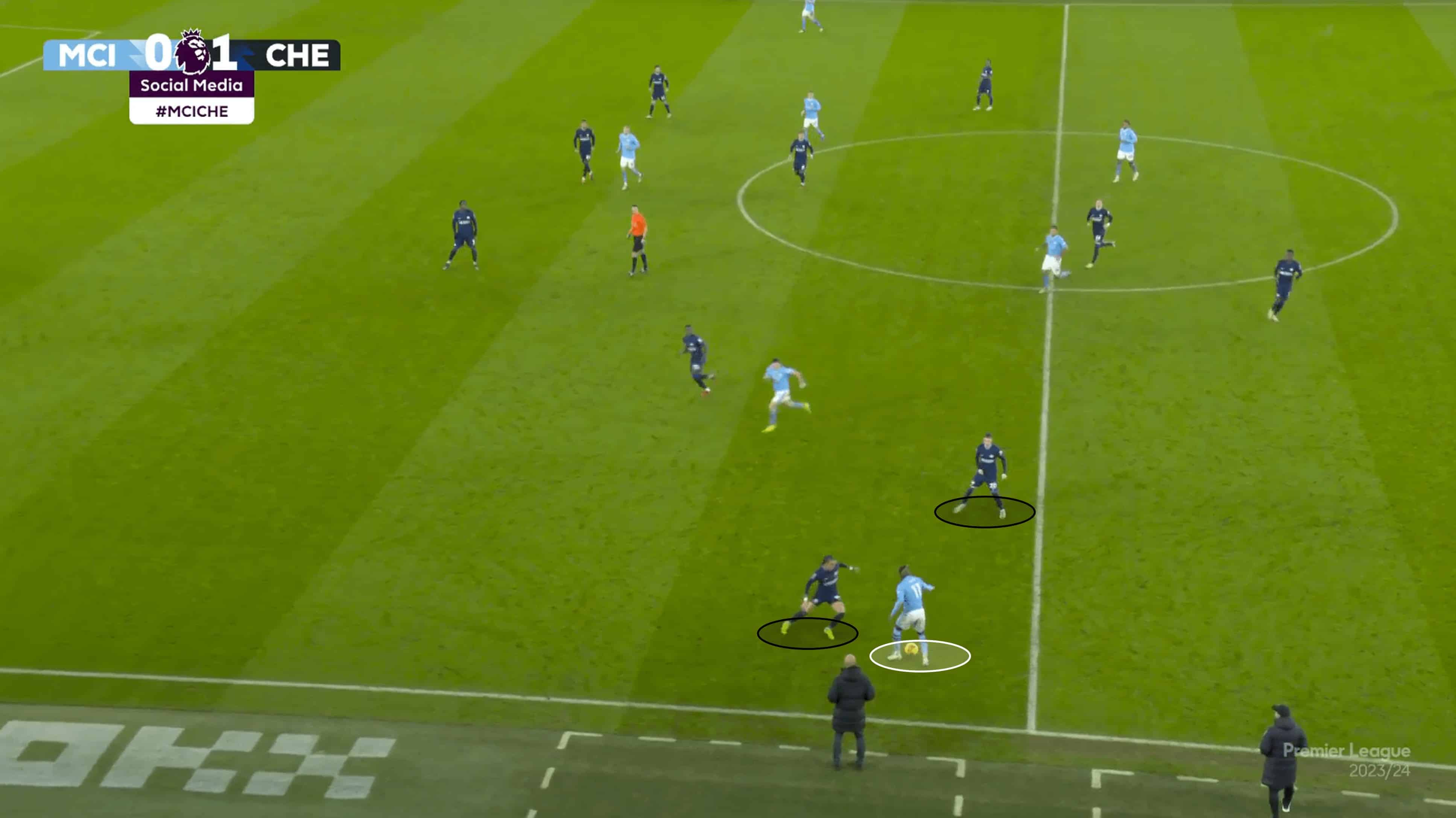
Doku has received his fair share of critics in recent weeks, but the 21-year-old is clearly highly rated by Guardiola, with the former Rennes player starting 15 games in all competitions this season – in a team where Guardiola likes to chop & change his starting lineup, that is not a bad number for his first season in English football.
One thing Doku does possess is pace, and he likes to drive from midfield areas where possible – Chelsea were keen to stop that, with one man pressing the Belgium international, and another close by to add to the pressure.
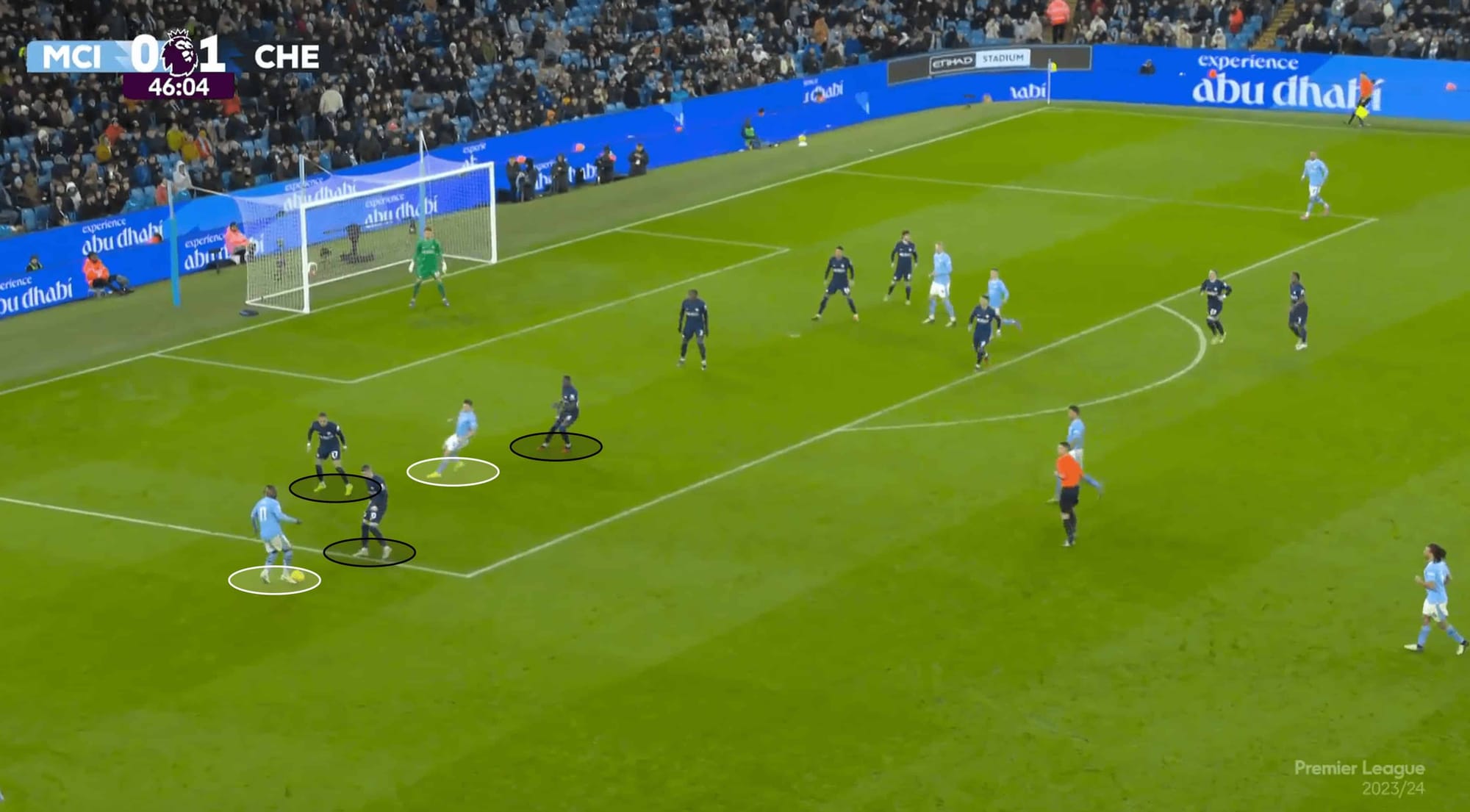
We saw similar defensive action being taken by Chelsea in their defensive third, as they would double-up on the winger to try and limit his threat in the final third. The positioning you see in the image above gives Chelsea cover – if Doku beats his initial presser and looks to drive toward the byline, there is a second defender ready to stop the winger. On the other hand, if Doku looked to cut inside, the two aforementioned defenders are backed up by a midfielder, essentially restricting Doku’s attacking prospects again.
The pair usually tasked with combining to combat Doku’s attacking attempts was Palmer and Gusto – Gusto, as you’d imagine for a right-back, was already usually on the scene when Doku collected the ball, with Palmer showing a good work rate to track back and provide that defensive assistance. City continued to try and attack down the left flank – they opted to try and overload the area with a higher midfield presence and movement, and Nathan Ake’s presence often acted as support for Doku.
Conclusion
Chelsea’s off-the-ball performance will have pleased Pochettino for the most part, and it could be something we see more of in the future if he can find a way to strike the balance between that and their usual possession-based tactics. City dealt well with the Chelsea press much of the time, in the sense that they were able to keep the ball in potentially dangerous areas and did find ways of beating the initial Chelsea frontline press.
An interesting tactical battle in a game that could have huge implications on the title race. Arsenal and Liverpool fans likely didn’t expect a Chelsea victory, even when the Blues had the lead with less than 10 minutes to go before Rodri’s equaliser, but they’ll be very pleased with a draw, particularly Liverpool fans, as it means City’s game in hand cannot take them to the top of the Premier League table.

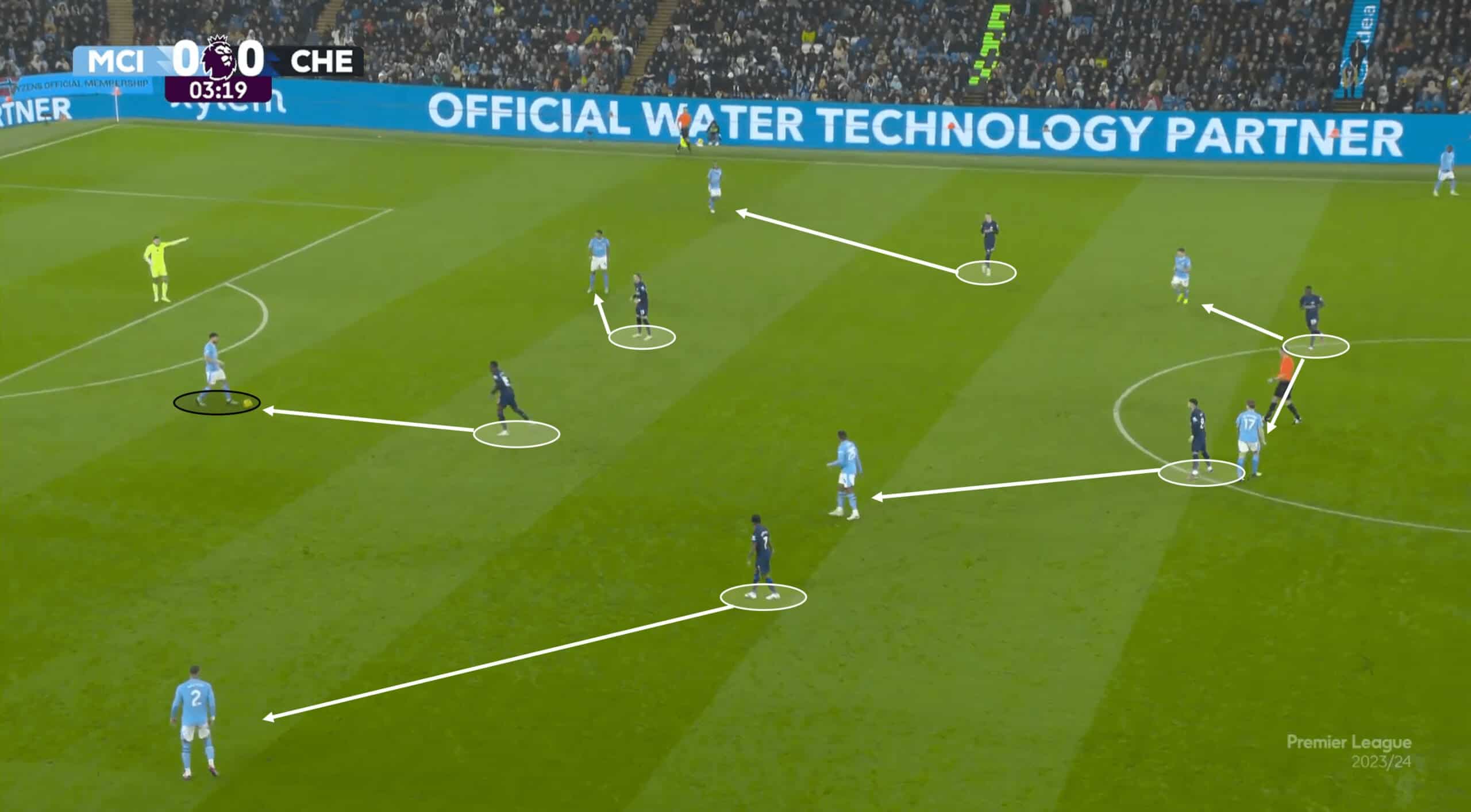




Comments